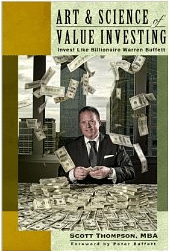Art & Science of Value Investing: a Book Review
When you decide to take the plunge and start investing your own money, a scary realization hits that you are now responsible for your own retirement.
Long time value investors – such as the ones that signed up to get a free net net stock checklist -- can find it easy to forget just how much they’ve developed since they first started out. When I first started tinkering with stocks, I was sitting in a room full of nearly graduated high school students listening to our teacher walk us through the idea of the stock market through a stack of charts. Somewhere along the way he mentioned the term “PE Ratio” which ultimately lead me to study value investing for over 10 years.
Here’s the thing, though – even with that lucky push into fundamental analysis, I would have been absolutely lost had I not dove head first into beginner investment books.
New investors have a mountain of choices when it comes to their very first investment book, so every so often I like to pull something down from the shelf and give it a read to see if it’s something I should recommend to others just starting out.
Who is Scott Thompson?
This past spring, the book, “Art & Science of Value Investing,” caught my eye.
If you haven’t heard of the book, or its author Scott Thompson, before, you’re probably not alone. Neither are big names in the investment world – though neither was Warren Buffett until he was featured in Adam Smith’s “Supermoney” in the 1970s. What drew me to the book was its unapologetically confident cover photo, and that snippet of title that communicated the true nature of value investing as both an art and a science.
After spending the better part of two weeks devouring the book, I’m left mostly, but not totally, satisfied. This write up will tell you exactly why that is.
What is the Art & Science of Value Investing?
Is “Art & Science of Value Investing,” the best investment book ever written? No, I don’t think so. I’m inclined to agree with Buffett when he says that title belongs to Benjamin Graham’s “The Intelligent Investor”.
It is a damn good book though – if you know what to expect before you pick it up.
And that’s absolutely key to making a purchase decision. Readers who have spent time reading other value investment books buy names such as Bruce Greenwald will find Scott’s book lacking in depth. But, that’s also a very strong positive for the book – Scott is writing for a different audience so seems more concerned about breadth of knowledge.
Scott Thompson definitely knows his stuff when it comes to investing. As an MBA grad and founder of the aptly named investment firm Intrinsic Value Capital Management, Scott is someone worth listening to. His depth of knowledge about the markets and value investing is unmatched by a lot of other investment writers and he attempts to share that wealth of knowledge through his book.
Where Art & Science of Value Investing Excels
The people who will find this book most useful are those investors who are just dipping their toes into the world of investing. If you’ve just wrapped your head around what a stock is and how they’re connected to actual real life businesses, then this book is for you. The same is true if you lack background knowledge of investment styles, and investment terms. Picking up “Art & Value of Investing” will get you up to speed, quickly.
As you might guess, Scott’s book does one thing particularly well: it provides a solid survey of some of the more popular value investment styles being used today. Low price to book value stocks, Buffett’s four filter investment strategy, his more recent two column strategy, weighted average cost of capital, discounted cash flow – those are all there and well explained.
In fact, Scott’s writing is very good. If you haven’t picked up an investing book due to your fear of being washed over by a tsunami of jargon and difficult concepts, you definitely have nothing to worry about. Scott is able to take complex aspects of finance and investing then distil them down into readable, understandable, bite-sized pieces.
Keep These in Mind Before Buying
Where the writing slips a bit is in its editing. If you’re a stickler for typos then your feathers will ruffle every ten or 20 pages when noticing a double-typed word or missing closing bracket (Though, if you’re really that anal about the occasional mistake, I’m not sure why you’re still reading Net Net Hunter.). In the end, though, I would rather have substance than perfection – and Scott delivers.
While we’re talking about the book’s weak points, I have to admit that I was disappointed when I first picked up the book and started through the first few chapters. As with a lot of modern value investing books, the main focus of “Art & Science of value Investing” is on Warren Buffett’s contemporary investment style. Yes, the book does provide an overview of other investment styles – but Scott always brings the discussion back to Buffett’s thoughts, actions, and philosophy.
That’s not necessarily a bad thing. Most of my own understanding of investing has been developed through a detailed reading of Buffett’s shareholder and partnership letters. But, if you’ve been reading Net Net Hunter for a while now, you’ll be well aware of the danger of slipping into the Warren Buffett trap. Since I’m not a Warren Buffett-styled investor, nor do I recommend his investment style for average retail investors, these parts of the book didn’t resonate with me. In my opinion, other value investing styles are both easier to use and provide much larger returns.
Suffice it to say, there’s little coverage of net net stock investing. Aside from some definitions and a brief explanation of the basic philosophy, deep value investors are left in the cold in favour of more mainstream strategies. DCF and WACC are both given substantially more real estate. Due to that, this is not for those looking to learn more about Benjamin Graham's most profitable investment strategy.
Two Fantastic Pieces of the Puzzle
On the other hand, Scott’s discussion of investor temperament blew me away. I have never read such insightful writing on such a crucial part of investing before – and I was surprised to see just how much Scott’s thoughts mirror my own. I can’t state this enough – especially for new value investors – cultivating the right investor temperament is fundamentally important to investing and Scott’s book is a great place to start.
I was also impressed with the forward by composer Peter Buffett, Warren Buffett’s son. Somehow Scott and Peter managed to spark a friendship that’s continued for years. To my surprise, Peter Buffett’s writing is itself very engaging and the message he shares – that money isn’t life – is both valuable and sobering. Where else can you read the son of one of the richest people in the world tell others to value things of true significance?
To Buy, or Not To Buy? – That is The Question
At this point you’re probably looking for a buy or avoid recommendation from me. So, what’s the final verdict?
The truth is that this book will mostly appeal with certain investors, but not others. If you already have a strong depth of knowledge when it comes to investing and investor psychology, then this book won’t add much. The same goes for those who want to dig deeper into Benjamin Graham's legendary net net stocks strategy.
On the other hand, as a tool to learn about some of the more common value investment strategies, the book is great. Newer investors who are looking for a discussion of Buffett’s contemporary investment styles will also be pleased with “Art & Science of Value Investing”. Anyone who reads the book is sure to come away with a much sharper understanding of what it is Warren Buffett does, and the steps that need to be taken to try to invest like him – if that’s what you’re into. If that's you, the book is definitely worth picking up.
Get a free net net stock essential guide. No catch, no obligation, just our free net net stock essential guide you can use. Take two seconds and enter your email address in the box below.







